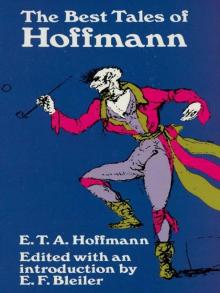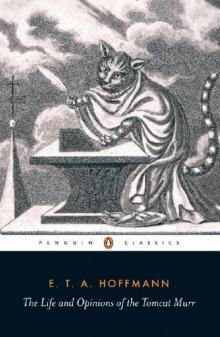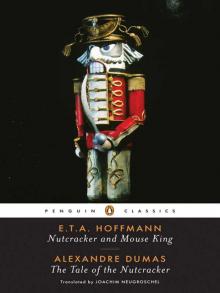- Home
- E. T. A. Hoffmann
The Best Tales of Hoffmann Page 2
The Best Tales of Hoffmann Read online
Page 2
Despite his appetite for drink and good companionship, Hoffmann was a first-rate administrator and judge, well versed in the law, very conscientious and just. This conscience was to cause him, indirectly, his next crisis. Hoffmann had been appointed by the King of Prussia to a commission to investigate subversive activities after the end of the Napoleonic adventure. Under subversion were included political liberalism, French sympathies, support of Napoleon, local nationalism and many other areas of thought and action. Hoffmann, who was unpolitical and not a nationalist, still took the “Voltairean” position that others had rights to their opinions; he refused to take part in a witchhunt. The King thereupon formed a second committee of investigation, with powers and duties that overlapped with the first. The two committees collided almost immediately.
The immediate source of Hoffmann’s approaching downfall was the case of “Father” Jahn, the founder of the Turnverein movement, which combined gymnastics with violent nationalism. Hoffmann’s committee investigated Jahn and discharged him as innocent. The second commission, however, immediately placed Jahn under arrest again, thereby creating an impossible legal situation. Hoffmann, who disliked Jahn and his movement, felt that injustice was being done, and undertook to interrogate the second commission. The situation became so tense that the King was forced to intervene. What with the publicity that the incident had received, the King was forced to support Hoffmann’s group, no matter what his own wishes may have been.
Hoffmann won this battle, but lost on a larger field. Just as he had made enemies in Poland by drawing cartoons of the military authorities, he now very foolishly satirized his principal opponent in Meister Floh, a novel he was then working on. He was even indiscreet enough to boast of his action. Meister Floh was being printed in Frankfurt, which was then a different country, so that diplomatic representations went back and forth between Prussia and Frankfurt as the Prussians worked to have the book suppressed. Hoffmann tried to save the situation by proposing alterations, but his attempt was taken as an admission that his work was improper. He was then cited for trial for unbecoming behavior.
Hoffmann now seemed lost, but his friend Hippel intervened once again. Since Hoffmann was by now quite far along the path of the sickness which was to prove mortal, the process was a perfunctory discussion in Hoffmann’s own house. Hoffmann escaped with an official reprimand, a serious enough punishment, but as circumstances turned out he did not live long enough to receive it.
Hoffmann’s health had started to break down before 1820. He had long had digestive difficulties—which were not helped by heavy drinking and overwork—and his liver became more and more troublesome. By the end of 1821 he was quite seriously ill, and to his liver degeneration was added a neural disorder which is not diagnosable with any precision, but seems to have been tabes dorsalis. Paralysis set in early in 1822, beginning with his legs, then his hands, and finally much of his body. His finances approached bankruptcy, and he found it necessary to continue working up to his deathbed. He dictated the last portions of Meister Floh, worked upon further stories and, optimistic to the end, was planning new series of reminiscences by the Tomcat Murr and Kreisler. He died on June 25, 1822, not long after dictating “Die Genesung” (“Recovery”).
II
Music was Hoffmann’s first love and his true love. He tried to make a living as a composer, but was forced to take up literature as a livelihood. Yet even in his later life, when his income was assured with fiction, he invoked music in his stories whenever possible. He delighted in writing about the lives of musicians, in comparing the music of his day with that of the past, and in analyzing the dynamics of musical creation and performance. In honor of Mozart he changed his middle name from Wilhelm to Amadeus.
His unique mixture of literary and musical gifts made him the foremost music critic of the day. He had an almost unerring ear for the best in music, and his papers containing the analyses and estimations of his character and mouthpiece Kreisler were eagerly read and discussed all over Germany. He was one of the first to recognize the merits of J. S. Bach, and one of the first critics to support Beethoven intelligently, for which he received a very laudatory letter from Beethoven. He also anticipated the critical work of both Carl Maria von Weber and Robert Schumann. Schumann acknowledged his debt by calling one of his piano works Kreisleriana.
As a composer, however, Hoffmann was more productive and less successful than as a critic. His known works include some ten operas; incidental music to more than a dozen plays; much vocal music, including two masses, several cantatas and many motets; a considerable amount of piano and chamber music; two symphonies, and quite a bit of miscellaneous work. No one really knows how much music he wrote, for most of it was never published and has been destroyed or lost.
Hoffmann was not a great composer, according to E. Istel and Hans Ehinger, two musicologists who have studied his work thoroughly. He was an excellent technician whose work somehow lacked the fire and spontaneity and brilliance of his prose—in other words those characteristics that made him a world figure in literature. It has been said that his music sounded much like Mozart’s (with a little Beethoven and Cherubini added), but without Mozart’s genius. Hoffmann was also unfortunate in maturing late. At about the time that he achieved a relatively personal style, he was forced to abandon music as a serious mode of life. Yet at times Hoffmann apparently did reach a high level. His opera Undine was revived occasionally in Germany before World War II, and it is said to have been a capable work, on the whole very pleasing.
Even if Hoffmann was not a great composer, his music was extremely important historically, for he was the first Romantic composer. It has been said that Weber and Schumann and even Wagner stand on his shoulders musically. Hoffmann may have been the first to write an opera on Germanic folklore; he certainly anticipated Weber. He was perhaps the first to create unusual program sound effects, as in his incidental music to Zacharias Werner’s Kreuz an der Ostsee, where braying instruments imitated the crashing waves and conveyed in this vivid manner the spirit of the pagan Lithuanians. In his use of new harmonies and progressions he is said to have anticipated Wagner, who was acquainted with both his music and prose. Unfortunately, none of Hoffmann’s music ever seems to have been recorded, so that we must remain content with accounts and evaluations of it at first remove.
Paradoxically, despite the death of practically all his own music, Hoffmann still remains very much alive in music, for his stories have been a fruitful source for operas.
The best-known of the operas derived from Hoffmann is, of course, Les contes d’Hoffmann by Jacques Offenbach. Offenbach’s last work and his first true opera, it uses a libretto by two veteran French dramatists, Jules Barbier and Michel Carré, who based their work on French translations of Hoffmann. In Offenbach’s opera Hoffmann himself is the hero and he narrates his experiences in love, thereby integrating several stories into a single biographical plot. The first episode, the adventure of the dancing doll, is adapted from “The Sand-Man”; the second, the famous Venetian episode with the barcarolle, from “A New Year’s Eve Adventure”; the third, the story of the singer Antonia, from “Rath Krespel.” Other stories contribute less important elements: the ballad which Hoffmann sings about Kleinzach of Eisenach is based on the story “Klein Zaches genannt Zinnober”; the name Pitichinaccio comes from “Signor Formica”; the Miracle Doctor who kills Antonia is a combination of traits from “Signor Formica” and other stories.
Before writing Les contes d’Hoffmann, however, Offenbach had set another story by Hoffmann to music, a light opera called Le Roi Carotte, libretto by Sardou. It was a political satire on Napoleon III, based on incidents from “The King’s Betrothed” and “Klein Zaches.” Some forty years after Offenbach’s death (1919) a third Offenbach-Hoffmann opera was created by Julius Stern and Alfred Zamara, who adapted music from Offenbach’s Corsaire Noir and minor works to a libretto based on Hoffmann’s “Das Fraulein von Scuderi.” The resulting pastiche was titled Der Gold
schmied von Toledo.
Other operas based on Hoffmann’s work include Die Brautwahl by Ferruccio Busoni (performed 1912); Prinzessin Brambilla by Walter Braunfels (performed 1909); Der goldne Topf by Wilhelm Petersen (performed 1940); La Poupée de Nuremberg by Adolphe Adam (performed 1852); La Poupée by Edmond Audran (1896–7); Nussknacker und Mausekönig by Carl Reinecke; and Paul Hindemith’s Cardillac (first version, 1926), which is based on “Das Fräulein von Scuderi.”
In the ballet, too, Hoffmann’s work has been important. Delibes’s Coppélia ou la Fille aux yeux d’émail is based on the dancing doll in “The Sand-Man.” Tchaikovsky’s Nutcracker (Casse-Noisette), based on Hoffmann’s “Nutcracker and the King of Mice,” is familiar to all. In this case Tchaikovsky worked with Alexandre Dumas père’s translation and adaptation of Hoffmann’s story rather than with the original.
It is as a writer of fiction, however, that Hoffmann stands as a figure of first importance. His stature was recognized at an early date outside Germany, and not too long after his death his work was extensively translated into French, in which language it spread widely through Europe. Russian literature was especially influenced by Hoffmann, with all the major figures in the later 19th century heavily indebted to him. Dostoievsky, for example, frankly admitted his debt, particularly in psychological matters. In the English-speaking world, however, Hoffmann has been less fortunate. Although certain major authors like Scott, Carlyle, Poe, and Hawthorne have known his work, translations into English have been few, poor, and difficult to obtain.
Some of Hoffmann’s fiction was written hastily, under time pressures, to pay for expensive wines, to settle tavern bills, or, as a last resort, to pay living expenses. As a result he wrote potboilers, stories that lack the Hoffmann touch and might have been written by one or another of the minor fiction writers of the day. An odd point about these stories is not that they date from a period of immaturity, as might have been guessed if their dates were not known, but that they are sandwiched in among his best work.
Hoffmann’s best work, however, is sui generis. There are few writers who can match him where the principle of Serapionism is concerned—the technique of presenting the supernatural convincingly. He can arouse momentary conviction and acceptance for even the most outrageous fantasy, leading the reader, as in “The Golden Flower Pot,” from the prosaic Biedermeier streets of Dresden into the wildest wonderland achieved in literature up to his time. The greatness of his achievement here can be seen by comparing his work with the Romantic short stories that preceded it. Hoffmann is also a very subtle writer, with a remarkable ability to merge levels of explanation, blending literalistic fantasy with allegory, symbolism, philosophy, and the psychology of the day. The result is a very personal amalgam which is worlds removed from the crudities of The Horrid Mysteries and similar Gothic material that stimulated him when he was young. And yet he is often elusive and tricky, and the reader may often discover that he has not always fathomed Hoffmann’s true meaning at first reading.
Technically, Hoffmann at his best was very strong. Characterization was one of his fortes, and strange personality after personality emerged from his pen. No matter what their origin—whether very deliberate embodiments of contemporary psychological theories, or fragments of himself, or caricatures of his friends, or whatever else—they carry conviction. Experimental forms in which stories are told from the point of view of the “wrong” character, where letters alternate with editorial reflections, where essays on musicology interrupt the narrative, where characters split and combine, where his characters reflect back on Hoffmann’s works—all of these are handled masterfully. Hoffmann usually remains in control and does not lose his individuality or become swallowed in confusion as so often happened to his Gothic prototypes.
In imagination, too, Hoffmann has few peers. The little touches of fantasy—like the remarkable ambassador from the Vegetable King in “The King’s Betrothed,” the magical battle between the Archivarius and the witch in “The Golden Flower Pot,” the sorcerous duel of the microscopists in Meister Floh, the theatrical world of 17th-century Rome in “Signor Formica”—these are among the parts of Hoffmann’s work which will always be cherished.
Yet Hoffmann does have faults, despite his many excellences. He is sometimes too sentimental, particularly when he is writing under the influence of Jean Paul Richter. This sentimentality, however, is an isolated phenomenon, and seldom affects the hard brilliance of his work. His experiments with form, in addition, occasionally do not come off. At times he seems to have arrived at the end of a story with no clear idea of how to close it convincingly. In such cases he gives the impression of having cleared the stage as rapidly as he could, with some impatience. His personality sometimes obtrudes into his work, and he is not always a well-balanced writer. Much of his thought, if stripped below the narrative level, and, sometimes, placed in his life situation, is not pleasant. Goethe, who could admire aspects of “The Golden Flower Pot,” applied to Hoffmann’s work as a whole the 19th-century equivalent of “sick, sick, sick.”
Still, if Hoffmann lacks the serenity and balance of a Goethe, and is an excited and exciting man, his very lack of balance often creates a drive and motion in his work that Goethe’s sometimes lacks. Hoffmann is seldom dull. One of his strongest assets is his tremendous nervous energy and narrative drive; he must surely be one of the most rapid authors in all literature. His motion is breath-taking.
In the opinion of many modern scholars Hoffmann’s work represents not only the last chronological work of the German Romantic period, but also its culmination. As Professor Ralph Tymms has pointed out, Hoffmann channelled the Romantic impulse, particularly the supernaturalism which was its heart, into a final bed from which it could not break. For Novalis the supernatural was numinous, poetic, and ethical; for the Schlegels it was philosophical and critical; for Tieck it was self-laughter; for the minor writers, it was emotion—thrills and longing; and for Hoffmann it was science. Once the misty ideas of the anti-Enlightenment were themselves organized into the clarity and logic of a legal brief, and the supernatural became merely a division of abnormal or depth psychology, the creative impulse could go no farther.
III
Most critics agree that “The Golden Flower Pot” (“Der goldne Topf”) is Hoffmann’s best story. Hoffmann himself considered it such, and while working on it, he wrote, “God grant me to finish the story as I have begun it. I have never done anything better; everything else is still and lifeless compared to it.” Nowhere else has Hoffmann been so successful in blending the real and the fantastic as in this story, in which the powers of the supernatural world run rampant through Dresden.
“The Golden Flower Pot” first appeared in 1814 in Fantasiestücke in Callots Manier, Hoffmann’s first collection of stories, and was revised slightly in 1819 for the second edition of the book. It is his first major literary work, and it marks his unheralded emergence as an author of world stature after he had written only a few critical essays and semifictional musical critiques.
It is a many-leveled story, and as might be expected, a great amount of time has been spent in trying to interpret Hoffmann’s intentions. Two opposing general interpretations have been the most favored: (1) that it is an optimistic story about the emergence of a poet, and (2) that it is a basically pessimistic story in which the sad problems of the poet are treated with irony. The proponents of optimism claim that this story mirrors Hoffmann’s excitement and joy at his decision to turn to literature instead of to music for his livelihood. According to the pessimists, however, Hoffmann states that a poet must abandon the life of this world, marry a dream girl of his own projection, neglect all worldly advantages—and where shall he go? To Atlantis, the mythical kingdom that does not exist and never did exist. At present the pessimistic interpretation seems the stronger, especially since the text incorporates a letter which Hoffmann first wrote to accompany the story. In this letter he stated his discouragement at the turn that events had taken.
/>
A modern reader, perhaps more than Hoffmann’s contemporaries, is likely to find difficulty in isolating and evaluating the various levels of interpretation that lie within “The Golden Flower Pot.” On the most superficial level, it can be read simply as a fantastic thriller, in which the supernatural emerges and invades the world of everyday life, just as supernaturalism within a pseudohistorical setting did in the Gothic novels that Hoffmann delighted in reading. Some of Hoffmann’s minor fiction, indeed, is written on this level, but it is very unlikely that “The Golden Flower Pot” is to be taken this way.
Beyond the external events of magic in Dresden and the emergence of the elemental world of the Renaissance Rosicrucians, for example, there lie several themes that appear in much of Hoffmann’s other work: that loss of faith or denial of revelation can be destructive; that there is a connection between madness and the suffering world; and that art and life do not mingle, but must be separated.
Individuation, in the modern psychological sense, offers one of the most plausible symbolic interpretations of “The Golden Flower Pot.” This amounts to a statement (in fantastic terms) of character growth. It is thus the story of the awakening of poetic sensibility in Anselmus, and of the upheaval which the new developments cause in Anselmus’s personality. According to this interpretation the incidents in the story are simply fictionalized metaphors. The old apple woman, Liese, is simply fear, and Anselmus’s hesitation before the doorknocker which assumes her shape is simply a metaphoric way of saying that Anselmus became frightened and did not enter. Serpentina would stand for Poesy; the strange experiences in the boat and around the punchbowl are simply ironic ways of stating that all parties had had too much to drink and that alcohol evoked the demonic forces within each. The enclosure of Anselmus in a glass bottle simply describes the paralysis which occurs when faith and hope have been lost. According to this interpretation the entire story of “The Golden Flower Pot” is the projection of Anselmus’s mind. His emergent sense of ecstasy colors and transforms everything he beholds, and the daily life of a staid, bourgeois early 19th-century city is seen as a mad scramble of occult powers, half-insane super-humans, strange perils and remarkable benisons as Anselmus becomes a poet.

_preview.jpg) Weird Tales. Vol. I (of 2)
Weird Tales. Vol. I (of 2)_preview.jpg) Weird Tales, Vol. II (of 2)
Weird Tales, Vol. II (of 2) The Best Tales of Hoffmann
The Best Tales of Hoffmann The Life and Opinions of the Tomcat Murr
The Life and Opinions of the Tomcat Murr Nutcracker and Mouse King and The Tale of the Nutcracker
Nutcracker and Mouse King and The Tale of the Nutcracker The Sandman
The Sandman